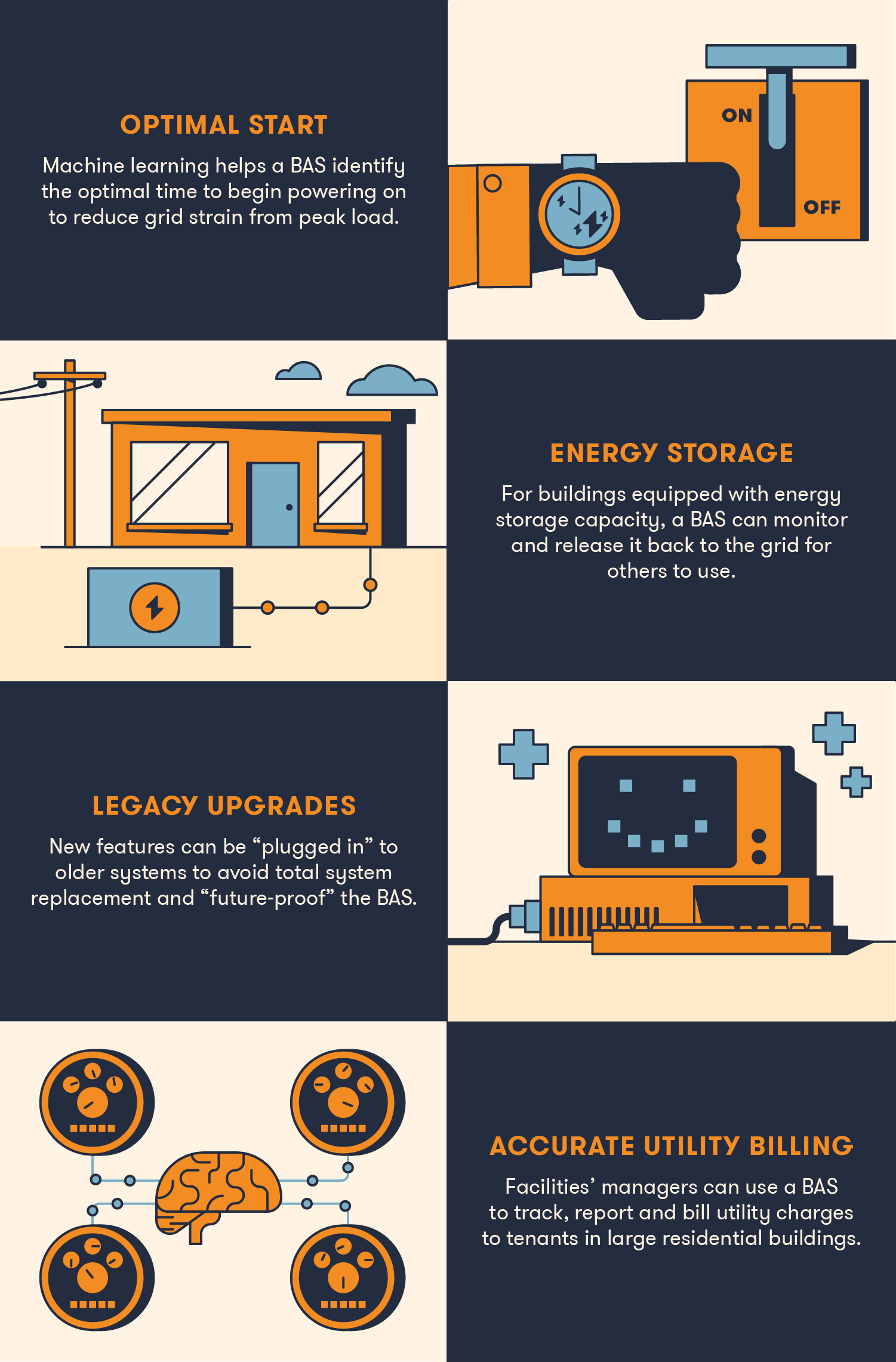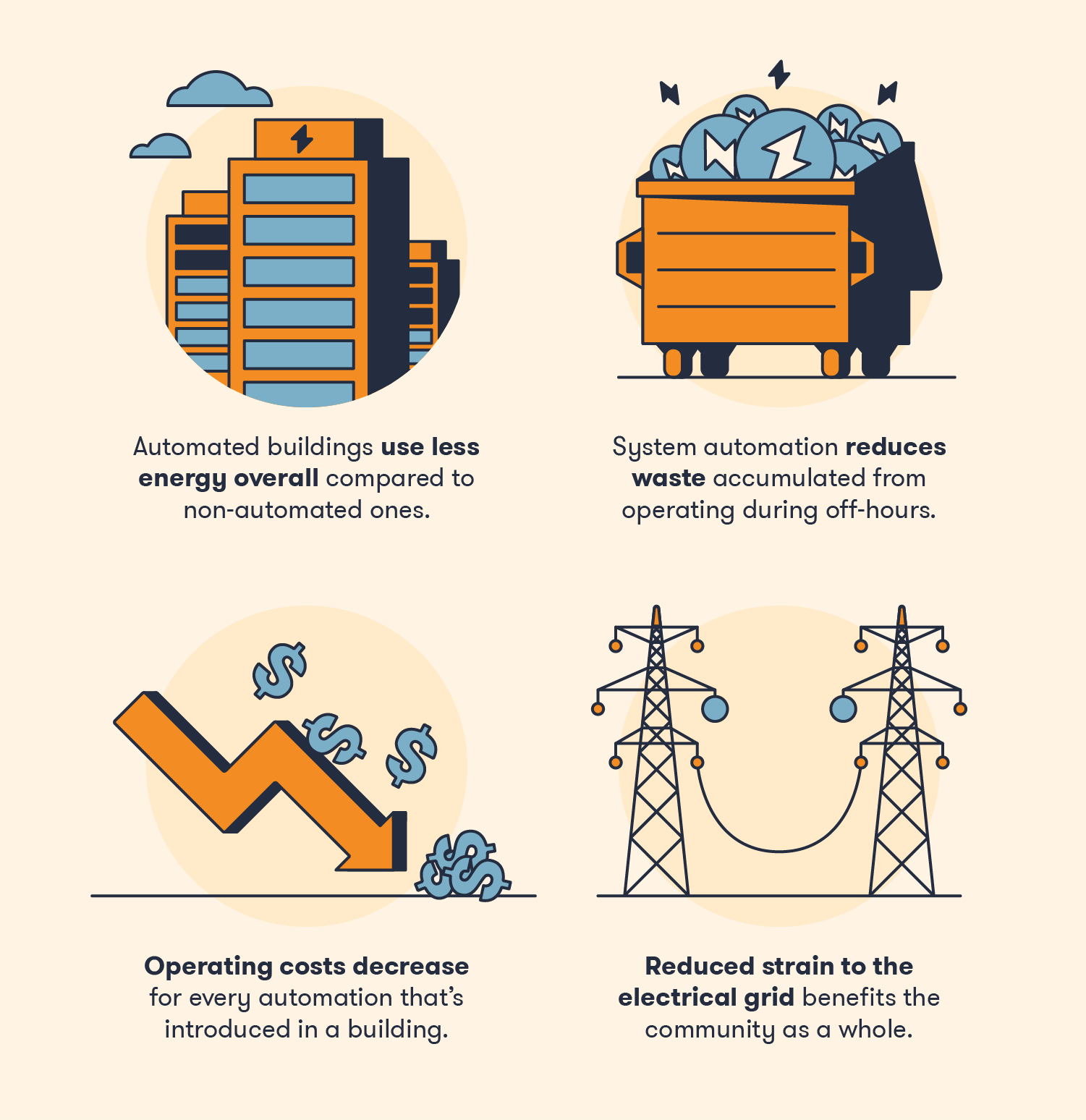Building automation is a system of controls that commands the operation of necessary building functions. Automation can affect several aspects of a building’s daily operations, but most commonly controls HVAC and electrical systems. Building automation runs via a BAS, or Building Automation System, that manages all of a building’s connected automations.
Automation, especially when coupled with artificial intelligence, is a growing trend paving the way for a smarter and more efficient construction industry as a whole. BAS technology is already common, but now it’s seeping into new phases of construction as well. Many green buildings utilize a BAS to limit energy consumption and increase operating convenience for occupants.
Integrated building automation naturally reduces energy waste and shrinks energy consumption habits by regulating operations. This makes a BAS a tremendous asset for developers who want to downgrade the carbon footprint of their projects.
First, we’ll dive first into the basics of building automation before exploring its eco-friendly benefits. Make sure you scroll to our infographic below for a visual breakdown of these environmental benefits. We hope this proves useful for you in making a decision about a building automation system in your next project— make sure you have solutions for all your construction industry questions before you begin.
The Basics of Building Automation Systems
Building automation systems manage all automated aspects of a building’s operation. This includes HVAC and electrical systems, and can also encompass security, plumbing and mechanical systems. The responsible management of these systems individually by humans is difficult and costly. Thankfully, building automation takes out the guesswork and maximizes efficiency.

There are four “layers” to a building automation system. Each is responsible for carrying out a different portion of the automation process, from user input to action follow-through. These layers form the basic structure of any BAS, from simple to complex. They are:
- Input/output layer: various sensors collect data throughout the building
- Field control layer: assesses data collected by inputs
- Supervisory layer: “central router” collects information from the field control layer
- Application layer: organizes data from supervisory layers and presents it to the user
These layers ensure the tidy delivery of all BAS operating statistics to one user interface so that the entire system can be monitored at once. This not only speeds up normal operations but can efficiently detect and report problems in the earliest stages. This fast-acting approach makes BAS systems a great choice for green buildings with many interconnected systems.
How Building Automation Can Achieve Environmental Benefits
With automated building operations, facilities management costs decrease as systems regulate the operation of building features like HVAC and lighting. Automation also decreases total energy consumption, creating an environmental win that can help a building become green-certified. Some buildings can save up to 30% on energy costs by implementing automation.

BAS functions to limit energy usage as a whole and can result in a slew of environmental benefits that keep building occupants healthier and happier. Some positive outcomes of automation include lower energy usage and tapered waste that lead to cost savings. A building’s individual stress on the electrical grid also plays a factor, with automation severely reducing that strain.
1. Reduce Daily Consumption
Although a BAS doesn’t measure energy consumption, it can be triggered to operate within a certain set of usage threshold guidelines. For example, BAS with machine learning adapts to schedule HVAC systems to operate at low levels on days when the building receives lots of heat from direct sunlight.
2. Cut Back on Unintended Waste
Standard building automation controls lighting and HVAC systems. When a building is unoccupied or a wing is empty for a period of time, the BAS signals to shut off those systems that don’t need to function during off-hours. With artificial intelligence, a BAS can predict when a building will be unoccupied and plan system operations accordingly.
3. Save on Utility Costs
The cost to run a building can be tremendous, with operating costs amounting to three-quarters of total expenses during a building’s lifetime. By running operations via a BAS, systems shut down to maintain efficiency, thereby reducing total runtime and increasing usable life in the long term.
4. Give Back to the Grid
Large buildings that require huge amounts of energy to operate must also generate plenty of energy to offset that usage and be considered sustainable. Building automation systems can manage functions at intervals to reduce peak load, the building’s highest daily energy usage. This reduces strain to the electrical grid and allows the rest of the grid access to more energy.

Automated, Not Automatic
Building automation has completely changed the way our structures are managed. Automation systems are not always simple — a complex BAS can help a large building conserve massive amounts of energy annually.
However, large-scale projects can get complicated, especially when multiple contractors are involved. If each system is installed by a different professional, creating a uniform BAS that successfully “talks” to the right system can be tough. For example, a contractor may be unfamiliar with the BAS chosen for the project, or the BAS and a subsidiary system might be incompatible.
Opposition to BAS can even stem from ignorance of its purpose. Some old-school professionals might be concerned about the reliability of BAS or deem it unnecessary and expensive. In reality, it’s a control and not an appliance, so a BAS can’t malfunction in the same way as a machine and can even be upgraded to fit new applications in the future.
Building automation is everywhere. If it’s able to be turned on with a switch, then it can be controlled with automation. Even complex tasks that are normally human-operated, like managing traffic in a parking garage, can be controlled via BAS. With this level of customization, construction projects in the future will only grow more efficient and environmentally friendly.
Read more below in our building automation visual guide, and check out our other construction technology resources to plan your future projects.

Additional Sources: Science Direct | CXRE | REHVA | Johnson Controls | Odin